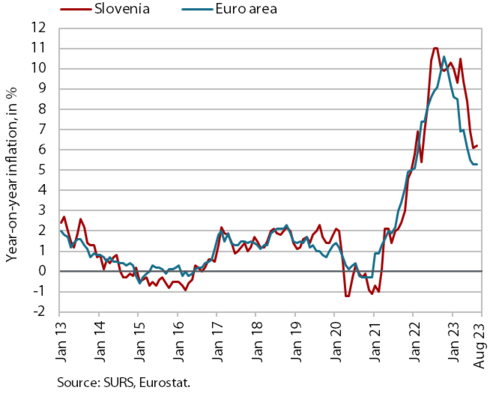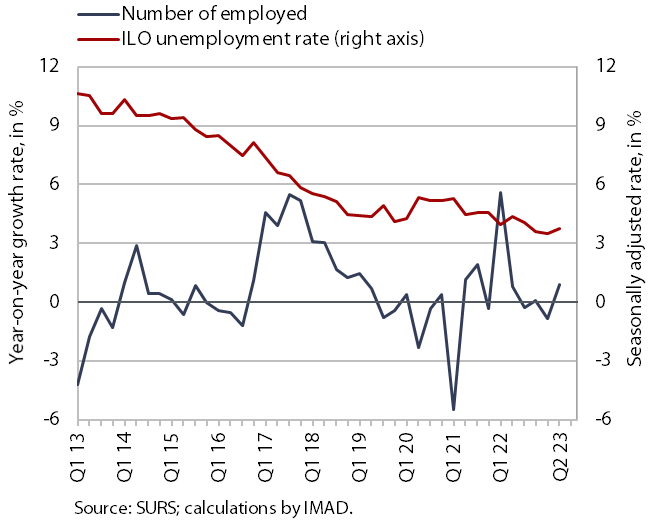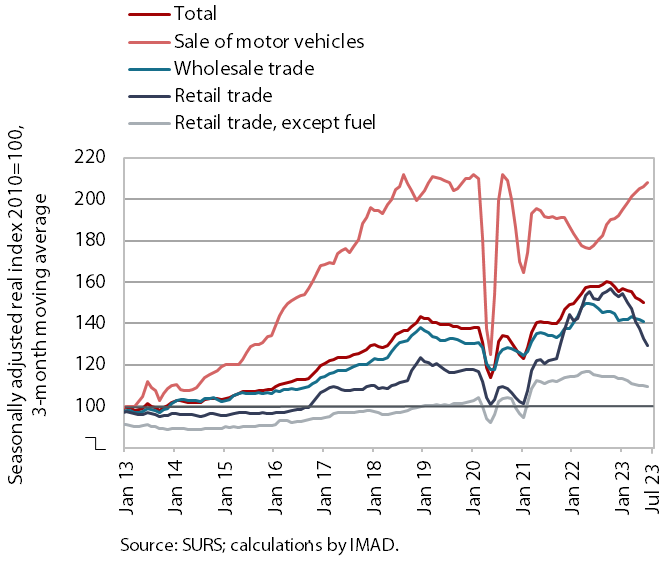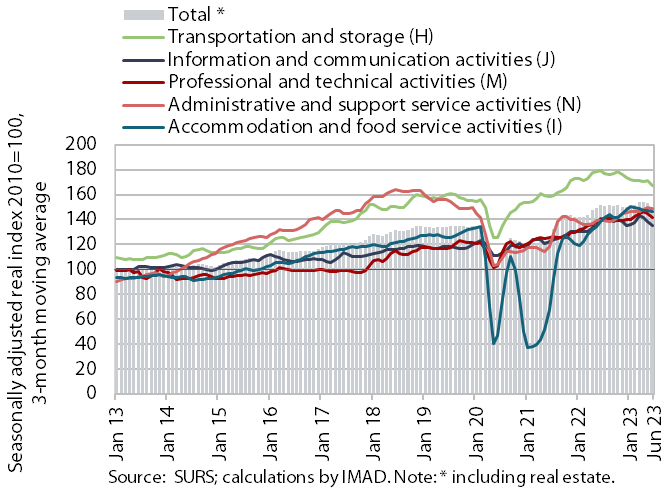Charts of the Week
Charts of the week from 28 August to 1 September 2023: consumer prices, active and inactive population, turnover in trade and turnover in market services
The year-on-year increase in consumer prices in August (6.2%) was similar to that in July. The largest contributors to inflation were still food prices, although their growth is slowing, and services, while the contribution of energy prices remains negative. Unemployment fell year-on-year in the second quarter also according to survey data, and the number of persons in employment increased. Real turnover in most trade sectors and in most other market services declined in the second quarter.
Consumer prices, August 2023

The year-on-year increase in consumer prices remained roughly unchanged in August (6.2%). Higher prices in the food and non-alcoholic beverages group (10.4%) are still the largest contributors to inflation, with the year-on-year increase continuing to moderate, albeit at a slightly slower pace than in previous months. After two consecutive month-on-month declines, prices in this group remained unchanged in August. The contribution of energy remains negative, despite the relatively large monthly increase in petroleum product prices (diesel prices rose by 5.1% and petrol prices by 4.5%). The relatively modest year-on-year growth of durable goods prices (1.8%) continues to weaken gradually, with growth in semi-durable goods (6.2%) also slowing slightly against the backdrop of a sharper seasonal price drop in the clothing and footwear group. Services price growth also slowed slightly, but remains high at 8%. Prices for goods and services in the health group declined slightly month-on-month in August, following relatively strong increases in previous months, but were still 11% higher than in August last year.
Active and inactive population, Q2 2023

According to the survey data, unemployment fell year-on-year in the second quarter of this year, while the number of persons in employment increased. According to original data, 37 thousand persons were unemployed, which is 15.9% less than in the second quarter of last year. The survey unemployment rate (3.6%, original data) fell by 0.6 p.p. year-on-year. The number of persons in employment was 0.9% higher than in the same period last year, with an increase in the number of self-employed persons and unpaid family workers and a year-on-year decrease in the number of employed persons.
Turnover in trade, June–July 2023

In most trade sectors, real turnover continued to fall in the second quarter; only in the sale of motor vehicles did it remain higher year-on-year. Turnover in the sale of motor vehicles, which has been increasing in current terms since the second half of last year, rose by 13% year-on-year. In the other two sectors, namely wholesale and retail trade (excluding automotive fuel), turnover continued to decline and was also lower year-on-year (by 6% and 5% respectively). Turnover in retail sale of food, beverages and tobacco fell by 4% and in the sale of non-food products by 6%. Among non-food products, the largest year-on-year decline,was seen in the sale of durable and certain semi-durable goods, as was the case also in the first quarter. According to preliminary SURS data, turnover in July was still lower year-on-year in retail trade and higher in the sale of motor vehicles.
Turnover in market services, June 2023

Real turnover in market services declined in most activities in the second quarter. After quite strong growth in the first quarter, total turnover fell by 2.4% in current terms. The decline in turnover deepened in transportation and storage, with the sharpest declines in airport and harbour freight transport. After high growth in the past, the largest decline was in information and communication activities, mainly due to a drop in turnover from computer services on the domestic market, while telecommunication services have been stagnant at 2019 levels for a long time. Professional and technical activities also saw a decline in turnover, due to a decline in all services except architectural and engineering services. Following an increase in previous quarters, the smallest decline in turnover was recorded in accommodation and food service activities. The only sector where turnover continued to grow were administrative and support service activities, where turnover declined only in travel agencies at the beginning of the summer. Year-on-year, total turnover fell by 1.2% in real terms in the second quarter. Broken down by activities, turnover in transportation and storage and information and communications was lower than last year. It remained below the pre-epidemic level (Q2 2019) in administrative and support service activities (by 5%), the most in employment services (by 24%).
